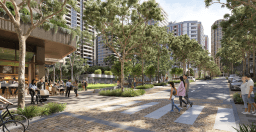What is walkability and why is it important?
The word ‘walkability’ buzzes about a lot, but what’s it actually referring to and why should you be considering it when looking for a new home?
You might assume that walkability is simply about how far away things like shops, services, transport and offices are from your house. But it involves more than simply looking at the distances between two points on a map.
The Greater Sydney Commission looks at walkable locations by assessing how built environments promote walking as a form of transportation, as well as the actual amount of walking activity done by locals. Factors such as housing density, width of footpaths, open space, the number of intersections and crossings per square kilometre are just a few of the things that impact a place’s walkability.
With more people working from home, walkable locations are becoming more sought after. But why it is important, how do they build a sense of community and what should you look for?
Walkability and wellbeing
Living a quick stroll to shops and services offers a convenient, connected and community-centric lifestyle, says Cameron Kusher, executive manager of economic research at REA Group.
“People don’t want to have to jump in their cars to go and do everything,” Kusher says. “They don’t want to be sitting in traffic, particularly in a busy city like Sydney. So, having the ability to get on public transport and to not have to use their car is really appealing.
“Being able to walk to a Woolworths or a Coles, being able to walk to get your coffee, or go to a restaurant, walk to retail stores, or being able to jump on a train into the city easily is really desirable.”
This convenience has a direct impact on wellbeing. According to the Greater Sydney Commission, incorporating walking into everyday activity helps increase a person’s mental health by 33% and reduces the risk of early death by 22%.
The CSIRO’s The Centre for Liveability Real Estate says the ability to ‘live locally’ is a key ingredient for not only your health, comfort and the bottom line.
“This includes being close to cafes, markets, cultural events, green spaces like parks and community gardens,” it reports. “When these resources are close to home you’re able to drive less, take public transport, walk or cycle — these are important for health and help you to reduce costs.”
Community focused
Walkability also helps build a sense of community, says Nigel Edgar, general manager of development at Frasers Property. It’s this sense of community which truly makes a place somewhere which is a great place to live.
“The great cities of the world, New York, Paris, and London, they’re all walkable, they’re all connected and easy,” says Edgar. “People like to be able to go for a walk after dinner, or to simply walk down the road and grab a coffee.”
Trips made by foot also increase the likelihood of social interactions with your neighbours. Edgar says that getting to know the people who live around you is a core component of building a sense of community.
“It might be small things like mothers’ groups, or simple get-togethers where you bring a plate of food from your nationality and learn about each other,” he says. “You then have a sense of belonging. It’s really about living life together.”
Walkability in action
With a focus on access to amenities by foot a key part of the definition, many people only think about walkability in relation to major metropolitan CBDs. But that isn’t the case.
The Great Sydney Commission’s vision for the future of the city involves three different walkable cities spread out over the region.
Some savvy property developers are focusing on walkability as the core of their new communities. They’re choosing prime locations that are connected to surrounding amenities, such as transport, education, healthcare, shopping centres and offices, and are building great facilities for residents to enjoy on site.
The Midtown at MacPark development by Frasers Property Australia in Sydney’s Macquarie Park is designed so that residents can simply park their car, forget about it, and embrace living locally, says Edgar.
“It’s 500 metres from the new Metro train station, there are cycle links, it’s 500 metres to Macquarie University, and less than that to Macquarie Business Park,” he says. Onsite, stores, cafes, restaurants, gyms, a 25-metre pool, health services, a childcare centre and much more will feature.
It’s no wonder that the CSIRO advises that: “Part of living in your most comfortable home is not inside the home at all.”
View original article - Link








